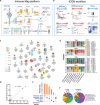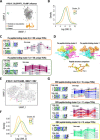A framework for highly multiplexed dextramer mapping and prediction of T cell receptor sequences to antigen specificity
- PMID: 33990328
- PMCID: PMC8121425
- DOI: 10.1126/sciadv.abf5835
A framework for highly multiplexed dextramer mapping and prediction of T cell receptor sequences to antigen specificity
Abstract
T cell receptor (TCR) antigen-specific recognition is essential for the adaptive immune system. However, building a TCR-antigen interaction map has been challenging due to the staggering diversity of TCRs and antigens. Accordingly, highly multiplexed dextramer-TCR binding assays have been recently developed, but the utility of the ensuing large datasets is limited by the lack of robust computational methods for normalization and interpretation. Here, we present a computational framework comprising a novel method, ICON (Integrative COntext-specific Normalization), for identifying reliable TCR-pMHC (peptide-major histocompatibility complex) interactions and a neural network-based classifier TCRAI that outperforms other state-of-the-art methods for TCR-antigen specificity prediction. We further demonstrated that by combining ICON and TCRAI, we are able to discover novel subgroups of TCRs that bind to a given pMHC via different mechanisms. Our framework facilitates the identification and understanding of TCR-antigen-specific interactions for basic immunological research and clinical immune monitoring.
Copyright © 2021 The Authors, some rights reserved; exclusive licensee American Association for the Advancement of Science. No claim to original U.S. Government Works. Distributed under a Creative Commons Attribution NonCommercial License 4.0 (CC BY-NC).
Figures





References
MeSH terms
Substances
LinkOut - more resources
Full Text Sources
Other Literature Sources

